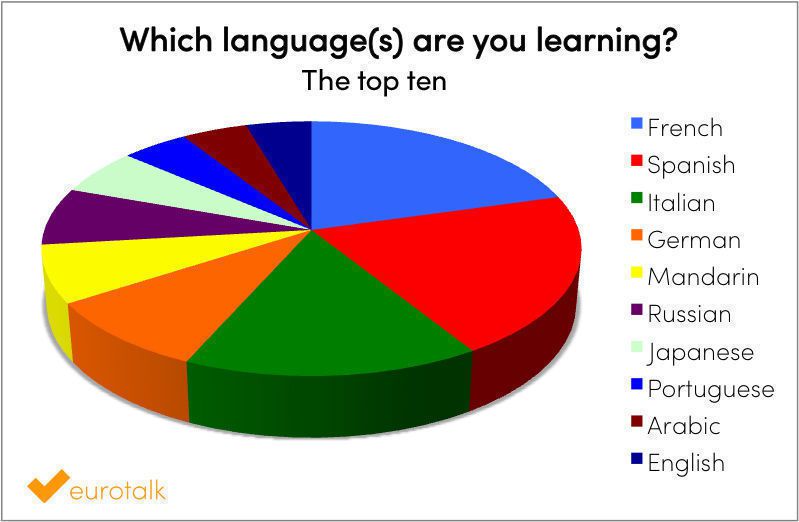Which language are you learning? The results!
We had a great response to our recent language learning survey; thank you to everyone who took the time to complete it. First things first: we’re delighted to announce that the winner of the iPad mini prize draw is Konstantia Sakellariou. Congratulations, Konstantia – your iPad is on its way!
We wanted also to share a few of our findings with you. Some of the results from the survey were as we expected, others were quite surprising. Here are just a few of the things you had to tell us. Thanks again for all your thoughtful responses, we’ll put them to good use.
Which language(s) are you learning (or would like to learn)?
The first question was pretty straightforward. A couple of people ticked every language on offer (over 100) – now that’s what we call ambition! – but most chose between 1 and 5. Here are the top ten most popular languages:  Other popular choices included Greek, Swedish, Dutch, Brazilian Portuguese, Norwegian, Irish, Polish and Icelandic. We also got some requests for languages we don’t yet offer, like Guernésiais and Twi – we’ll do our best to add those languages to our list, so watch this space!
Other popular choices included Greek, Swedish, Dutch, Brazilian Portuguese, Norwegian, Irish, Polish and Icelandic. We also got some requests for languages we don’t yet offer, like Guernésiais and Twi – we’ll do our best to add those languages to our list, so watch this space!
Why are you learning a language?
Next, we wanted to know why you’re learning a language. Nearly half of the respondents chose travel as a reason, and almost as many said they were learning a language just for fun. 36% of respondents said it was for family reasons or for a relationship, and 27% for work. The results were quite evenly split though, showing that there’s no one overwhelming reason – everyone has their own motivation.  Among the other reasons, we had a range of answers, including an interest in the culture of the language, personal challenge and wanting to follow literature, film and music in other languages. Many people are living in another country, which was their main motivation for learning the local language. And one person said that their heart asked for the knowledge, which we loved 🙂
Among the other reasons, we had a range of answers, including an interest in the culture of the language, personal challenge and wanting to follow literature, film and music in other languages. Many people are living in another country, which was their main motivation for learning the local language. And one person said that their heart asked for the knowledge, which we loved 🙂
What prevents you from learning a language?
We were also interested to know what stops people from learning a language, so we asked you to rate the following reasons out of 5. The most common barrier to learning is a lack of time, followed by not having found the right method, and then the cost involved.  Incidentally, if you’re facing any of these barriers, you may like to check out our recent posts, on finding time to learn a language and learning on a budget. And if you’re looking for resources, did you know you can try out the EuroTalk learning method for free? Either visit our website, or download our free app, uTalk for iOS, to give it a go. We believe learning a language should be fun, because our research shows we learn much better if we’re enjoying ourselves, and this in turn makes it a lot easier to overcome the obstacles that get in the way. See what you think! Other answers included not having an opportunity to use the language, a lack of motivation and difficulty finding resources for the particular language they wanted to learn (we may be able to help there – we’ve got 136 languages and counting…).
Incidentally, if you’re facing any of these barriers, you may like to check out our recent posts, on finding time to learn a language and learning on a budget. And if you’re looking for resources, did you know you can try out the EuroTalk learning method for free? Either visit our website, or download our free app, uTalk for iOS, to give it a go. We believe learning a language should be fun, because our research shows we learn much better if we’re enjoying ourselves, and this in turn makes it a lot easier to overcome the obstacles that get in the way. See what you think! Other answers included not having an opportunity to use the language, a lack of motivation and difficulty finding resources for the particular language they wanted to learn (we may be able to help there – we’ve got 136 languages and counting…).
How have you used your language when travelling?
Finally, we asked how knowing another language has been useful when you’re travelling. There was no clear winner here, which just goes to show knowing a language is always useful! But the top response was that it gives you the ability to talk to locals in their own language; many people added that they felt more welcome as a result and that it gave them independence so they could make the most of their trip. There were lots of practical reasons too, with getting around and eating out narrowly beating shopping in the poll. If you missed out on the survey this time, don’t worry – we’re planning another one soon, so keep an eye on the blog (you can subscribe by email above to get the latest updates), or follow us on Facebook or Twitter. And if you didn’t answer this survey but would still like to have your say on any of the questions, you’re very welcome to email us or add your thoughts in the comments below.
If you missed out on the survey this time, don’t worry – we’re planning another one soon, so keep an eye on the blog (you can subscribe by email above to get the latest updates), or follow us on Facebook or Twitter. And if you didn’t answer this survey but would still like to have your say on any of the questions, you’re very welcome to email us or add your thoughts in the comments below.
Liz
Data above based on 877 survey responses.
10 reasons to visit… Brazil
Where else for this week’s ’10 reasons…’ post but Brazil? This huge, beautiful and unique country will be attracting tourists by the thousands over the coming weeks, so here are our top tips – whether you’re visiting for the football and have a bit of spare time, or you’re planning a holiday for later in the year.
1. Ilha Grande
A beautiful island off the coast of Rio, which can be reached by ferry (no cars allowed – there are no roads for them to drive on anyway). It’s a great place to see local wildlife, and also has a fascinating history, having been a pirates’ lair, a leper colony and a prison in its time.
2. Beaches
With over 7,000km of coastline, it’s no surprise that Brazil has a lot of beaches. It would be impossible to name them all, but a couple of the most famous are Copacabana Beach in Rio de Janeiro, which is particularly well known for its New Year celebrations, attended by about three million people each year, and Praia do Cassino, near Rio Grande in the south of the country, which is thought to be the longest beach in the world at an incredible 245km.
3. Languages
With over 180 indigenous languages, Brazil is a language lover’s dream. Although most tourists should be able to get around with a smattering of basic Portuguese, if you’re heading off the beaten track, you may hear people speaking Tupí, Arawak, Carib, and Gê languages, among many others.
4. Let’s dance!
Brazil is probably best known for samba, the African-influenced music and dance style now popular across the world, and celebrated most famously at the annual Carnaval in Rio de Janeiro. Samba is far more than just music; it’s a hugely important part of Brazilian culture, and you’d be hard pressed to visit the country without experiencing it (and why would you want to?). Capoeira is another well-known tradition, which combines dance, acrobatics and martial arts set to music. Someone once tried to teach me some capoeira moves at university. It did not go well – turns out it’s quite difficult, especially if you’re as uncoordinated as I am – but it’s great fun to watch.
5. Iguaçu Falls
Found on the border between Brazil and Argentina, the Iguaçu Falls (or Iguazu Falls if you’re in Argentina) are one of the region’s most famous natural landmarks. There are 275 waterfalls in total, along a 2.7km stretch of the Iguazu River. Be sure to see the Devil’s Throat, a U-shaped chasm right on the border between the two countries, and if you can, take a boat trip under the falls for the ultimate water ride.
6. Christ the Redeemer
Another world-famous landmark, and one of the New Seven Wonders of the World, the 124 feet high statue of Jesus Christ hit the headlines last week when travel blogger Lee Thompson was given permission to climb to the top to take a selfie. Towering over the city of Rio de Janeiro from the top of the Corcovado mountain, the monument is a must-see if you go to Brazil. Unlike Lee, you won’t be able to go inside the statue, but you can visit the chapel in the pedestal at its base and the views from the mountain are still amazing.
7. Sea Kayaking in Paraty
Staying in Rio, if you want to get away from the crowds, why not try a spot of sea kayaking in Paraty Bay? Whether you’re a beginner or an experienced kayaker, this is a great way to enjoy fantastic views of the town and mountains, relax on the beautiful sandy beaches and explore a mangrove forest on your way to the base of the Sugarloaf mountain.
8. Amazon
The rainforest, not the website. Not an area to venture into unprepared, or alone, obviously, but great if you’re tired of the cities and want to get back to nature. Take a boat trip down the river, have a treetop adventure (there’s even a hotel), or try your hand at piranha fishing (not sure about that one, personally). The rainforest is full of wildlife, although many of the animals and birds will keep themselves to themselves, so if you do encounter any, it’s pretty exciting.
9. Food
Being a huge country, Brazil has many, many types of food, from feijoada (a black bean stew with beef and sausage), to pastéis (deep fried parcels containing pretty much whatever you like – cheese, beef, cod, you name it), quindim (a custard dessert made from sugar, egg yolks and coconut) to bolinhos de chuva* (fried doughballs sprinkled with sugar and cinnamon). It’s safe to say that whatever your tastes, you’ll probably find something you like in Brazil.
* I’m tempted to go to Brazil right now for some of these.
10. Football…?
Someone told me there’s a big football tournament happening in Brazil this month, so if you’re a fan, now might be a good time to visit. I don’t know about that, but I do know Brazil are a huge footballing nation. They’ve won the World Cup (that was it!) five times, more than any other nation, and will be hoping to make it six in a few weeks. If they can get past England, obviously…
If you are visiting Brazil, remember to learn some basic Brazilian Portuguese before you go – it’ll make everything a lot easier and much more fun. Take uTalk for iOS with you and you’ll never be lost for words!
I realise I’ve barely scratched the surface of what this huge country has to offer, so if you want to share any tips of your own, please do so in the comments.
Liz
It’s Raining Cats and Dogs (and Wheelbarrows and Old Ladies)
‘It’s raining cats and dogs!’ is a common British phrase meaning that it’s raining particularly hard. There are various theories as to where the expression came from – although there’s no evidence that it’s ever actually happened!
It may come from the Greek expression cata doxa. This means ‘contrary to experience or belief’ and might explain why the expression is used when it’s raining unusually hard.
Equally, it could be derived from the old French word catadupe, which meant waterfall.
An old theory was that in heavy rain, dead animals would often be washed out of drainage systems on 17th century buildings in Europe.
There’s no conclusive answer. It may just be that it was a funny expression that caught on and became popular. We’ll probably never know…
In Britain it also rains buckets, stair rods, tacks and pitchforks… But did you know that in other areas of the world, it rains other things?
Our favourites are:
‘It’s raining wheelbarrows’
Czech: Padají trakaře
‘It’s raining knives and forks’
Welsh: Mae hi’n bwrw cyllyll a ffyrc
‘It’s raining shoemakers’ apprentices’
Danish: Det regner skomagerdrenge
‘It’s raining fire and brimstone’
Icelandic: Það rignir eld og brennustein

‘It’s raining lady trolls’
Norwegian: Det regner trollkjerringer
‘It’s raining husbands’
Spanish: Están lloviendo maridos
‘It’s raining old women with knobkerries’
Afrikaans: Ou vrouens met knopkieries reen (by the way, a knobkierrie is a kind of African club!)
‘It’s raining snakes and lizards’
Brazilian Portuguese: Chovem cobras e lagartos
‘It’s raining frogs’
Polish: Leje zabami
We’d love to know where some of these expressions came from, so if anyone has any information, please share it in the comments!
Do you know who you’re talking to?
Our post today is by Izabella Klein, who’s been working with us to translate our maths apps into Brazilian Portuguese. Izabella’s post is about the importance of getting to know your target audience as a translator, and understanding more than just the words used.
Have you ever read an article, document or webpage in your own language that you can clearly see has been translated from another language? The sentences don’t really make sense, or have wordings that are not commonly used where you come from or where it’s been published. Do you get bored or lose interest because of this? I would say most likely yes!
There are two main reasons for this. One, it has been translated by a translation device. Or two, it has been translated by real people, but they were not careful to take into consideration the target public – you.
Reason number one I will disregard, because I strongly do not recommend this option for translation. But let’s go a bit deeper into reason number two, and look at why many translations are not handled carefully, to catch the attention of the readers, or even just make them understandable.
Let’s take the English language as an example. How many different countries in the world speak English as a first language? USA, England, Australia, some of Canada, some of Africa and even more. But, although it is all English, each one of them has a particular way of communicating; they use different words, they have different local parlance, slang and so on. Spanish is another language spoken worldwide as a first language; take Spain, Argentina, Colombia, Mexico, Chile, Peru, Venezuela and Ecuador for example. And even if we talk specifically about Spain, they still have other variations, such as Catalan and Galician.
So, even if someone is fluent in a specific language, that doesn’t mean they are capable of translating perfectly to that language in any place in the world where this is the native language. You must understand the minimum of their culture, their slang, and how they usually communicate something that you are interested in communicating to them.
I’ll take myself as an example. I’ve been working for Japanese people for the last couple of years as a linguist, using Portuguese and English as source and target languages. In the beginning it was a hard task. Much of what was said or written to me was difficult to understand: their awkward accent, the different words they used (words that are in the dictionary, but I’d never really heard people saying them on a daily basis), or incomplete sentences. So I had to get used to their weird English sentences, sometimes just random words that I had to put together like a puzzle and figure out the missing words. But, in the end, it was just a matter of adapting to their culture, or to JapanEnglish as I call it. Now, I feel 100% confident while working with them. I had to spend a year studing their different habits, and basically dig a way into making myself understandable in their language, in this case JapanEnglish.
You might say JapanEnglish is not really a language, but I argue that it is. It’s just a mixture of Japanese and English, the same way Catalan is a mixture of Spanish and French; and Galician a mixture of Spanish and Portuguese. The only difference is JapanEnglish is not an official language. My point here is that it’s important to realise why you must get to know your target public as deeply as possible, so that your translation work will be accurate.
I can also take my internship at EuroTalk as a second example of my work experience. I worked in app localisation, focused on teaching maths to very young children. Some might say it must have been an easy task. But actually it was not that easy. Children are different from adults, they use different vocabulary and they can easily get distracted. Plus, you can’t use a completely different vocabulary than teachers use at school, because the main idea is to reinforce what they will learn or are already learning at school; otherwise you might just confuse them, which will mean unhappy children and parents.
I know that for most linguists time is money, as it is for most people, but a piece of advice from what I have learned during my career is, take some time and effort to study your market. I believe that if you do, your chances of boosting your career are greater.
Izabella




